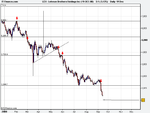Hi Everyone
I need a little help.
I am working on a strategy (slowly) and have no problem setting a Stop Loss limit, I simply decide how much I am prepared to lose on any given deal, However, I am a bit stuck on to how to work out a Limit on the order?
I know everyone wants to gain as many pips as they can on each deal and lose as little as possible so I was wondering if there is a formula I should be using to set Limit/Loss levels.
Any help appreciated.
Thanks
Carl
I need a little help.
I am working on a strategy (slowly) and have no problem setting a Stop Loss limit, I simply decide how much I am prepared to lose on any given deal, However, I am a bit stuck on to how to work out a Limit on the order?
I know everyone wants to gain as many pips as they can on each deal and lose as little as possible so I was wondering if there is a formula I should be using to set Limit/Loss levels.
Any help appreciated.
Thanks
Carl

